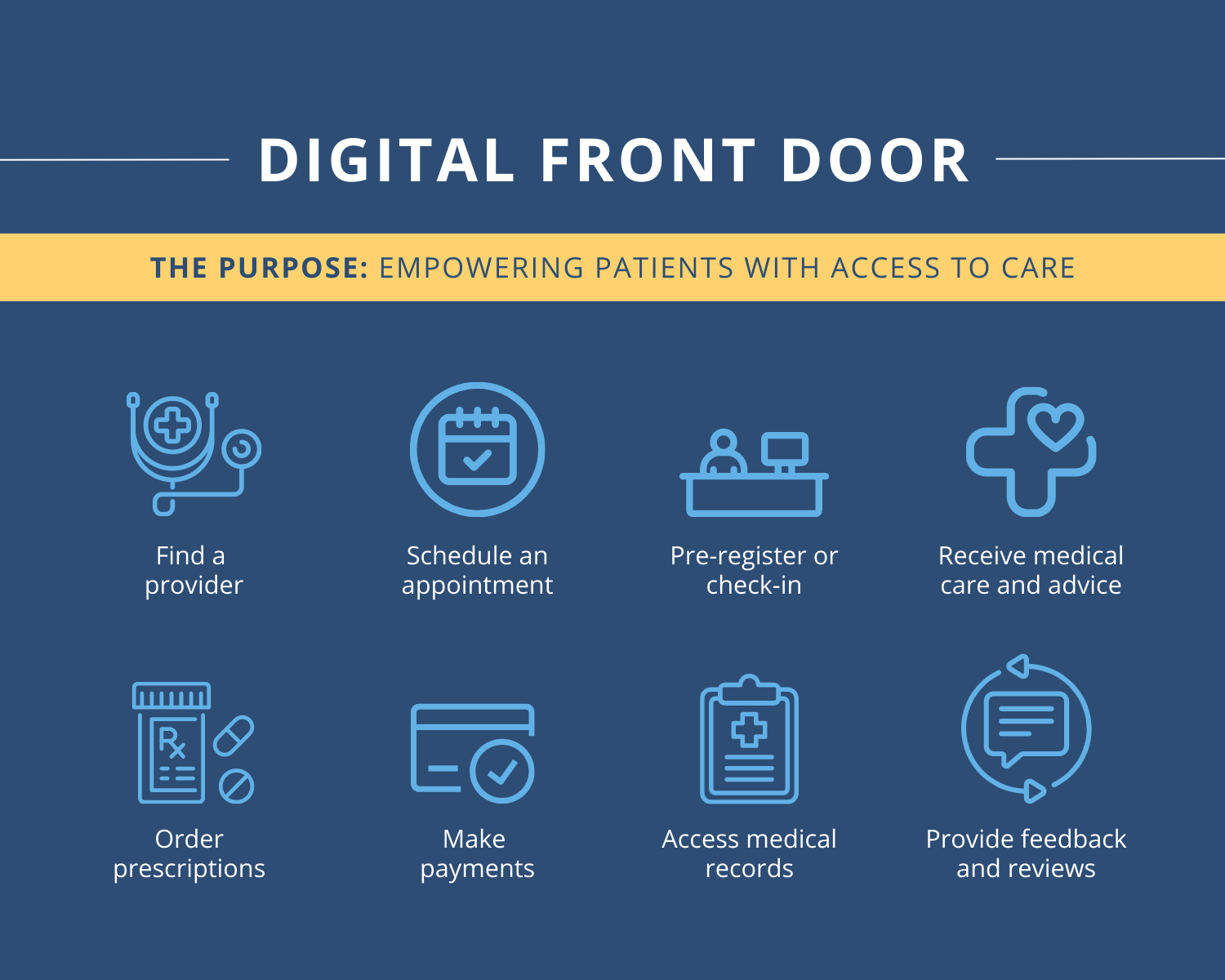HealthcareAI
The AI arms race in healthcare: Innovation without compromise
There are several key factors that healthcare organizations should consider when it comes to keeping up with the race…
Read article

03/28/2023
by S, y Khoury and Catherine Terilli

Healthcare systems have countless tools and technologies available when building their digital ecosystem. Leveraging the right combination of those tools and technologies can create the foundation your health system needs to have an effective digital front door.

Though having the right technology is important, your digital front door will only be as good as the strategy behind it, the data that informs it, the teams that run it, and the processes that maintain it. Without the right governance in place to ensure that each of these components is working in tandem, your health system may not reach its full potential when it comes to providing patients with access to care.
Beyond the specific digital front door strategy, most health systems are facing an increased challenge when it comes to approaching their technology strategy at large. One common challenge takes the form of disparate systems resulting from strategic partnerships, mergers, and acquisitions. Another obstacle comes from meeting a variety of patient needs, which is further impacted by variables like treatment plans, health literacy, and communication preferences. By assessing your and your patient population’s unique needs, you can define a more specific strategy that empowers you to unlock the potential of your full technology suite and, by extension, your digital front door.
Patient Benefits:
1. Improved patient experience. Optimizing your digital front door strategy directly translates into an improved overall patient experience, in part because of the ease of access for potential and current patients to book appointments, view medical records, and communicate with providers.
2. Improved health outcomes and quality of care. Health outcomes improve when patients have access to timely and convenient care. This is especially true when a virtual visit or digital conversation can serve as preventive care, reducing the need for emergency visits or hospitalizations down the road. At the same time, a robust digital strategy allows patients to access medical records and communicate that information to multiple providers, leading to a more holistic view of the patient’s history, medical needs, and care requirements.
Health System Benefits:
1. Increased efficiency. By streamlining some of the more routine tasks, including searching for a provider, scheduling appointments, accessing medical records, and checking insurance coverage, providers and other members of the health system’s staff are able to focus on patient care and troubleshooting more complex issues.
2. Right-sized capabilities. Ensuring that tools and technologies are implemented correctly and utilized to their full capacity allows health systems to make more prudent digital investments. Additionally, the visibility granted through effective data use can aid in pinpointing current cost or process inefficiencies and support the health system in making more informed business decisions.
By surrounding your technologies with the right people, processes, and governance, you can ensure that your patients are equipped with the right keys to open the digital front door.
1. Assess the current state of your digital strategy to get a clear understanding of what your strengths and opportunities are. This includes identifying your patient and end-user needs, completing an inventory of existing tools and technologies that fall under the digital front door umbrella, reviewing the underlying data that feeds into the tools, and taking stock of any existing processes and procedures.
The underlying data that is required for a digital front door strategy may exist in different sources, such as marketing and credentialing applications and EHRs. The different tools will likely be owned and managed by disparate groups and have different governance structures. When completing the current state assessment, it’s important to truly understand the key players, tools, and data sources that exist within your health system.
2. Assemble your key stakeholders to collectively visualize your goals. Understanding your short- and long-term strategy is a key step to determining the next steps in your journey. When looking at the future state, it’s imperative for your goals to align with the larger health system’s vision. It’s also important to account for the ways your patients’ digital experience will be influenced by the types of care you offer, the population you serve, and the physical location of your facilities.
3. Develop an actionable roadmap. This includes identifying key initiatives, prioritizing them by effort and impact, and incorporating change management to support the transformation. The initiatives documented should include the applications that need to be implemented, decommissioned, or integrated.
4. Mobilize your teams and start executing your plan. Develop project plans and timelines, document processes and procedures, ensure changes are operationalized and adopted, train your staff, implement new tools and technologies, and confirm that the underlying data is used appropriately.
5. Open the digital front door to your patients. After you’ve communicated with and trained your staff, it’s time to tell your patients about the different ways they can use the digital front door. Leverage different patient communication channels, including email campaigns, text updates, and direct provider communication.
Is your organization looking to unlock its digital front door? Knock knock–we have the keys! Connect with a consultant today to begin offering a suite of entry points to care for your patients.
Business insights
HealthcareAI
There are several key factors that healthcare organizations should consider when it comes to keeping up with the race…
Read article

Healthcare
While private equity investment in healthcare is valuable, providers should familiarize themselves with alternative…
Read article

HealthcareOptimize Technology
Advancements in health tech have allowed both patients and clinicians to experience the benefits of digital…
Read article
